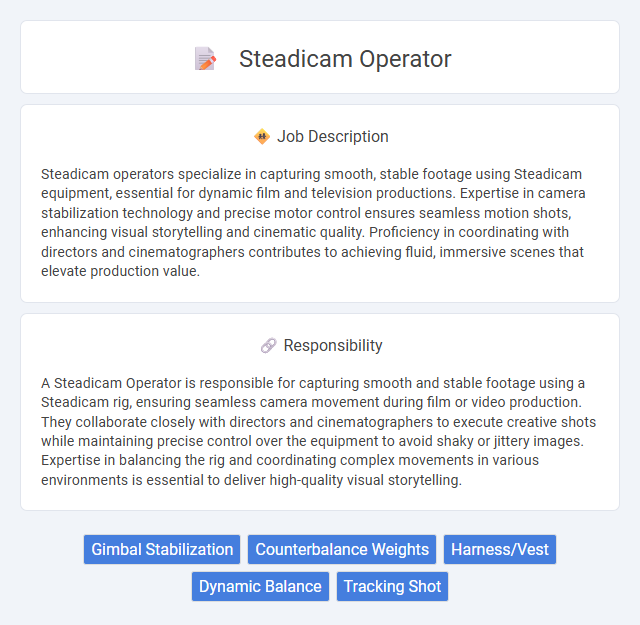
Steadicam operators specialize in capturing smooth, stable footage using Steadicam equipment, essential for dynamic film and television productions. Expertise in camera stabilization technology and precise motor control ensures seamless motion shots, enhancing visual storytelling and cinematic quality. Proficiency in coordinating with directors and cinematographers contributes to achieving fluid, immersive scenes that elevate production value.
Individuals with strong physical stamina and excellent hand-eye coordination are more likely to succeed as Steadicam Operators because the role demands steady, precise movements and extended periods of holding heavy equipment. People who thrive under pressure and have a keen eye for visual storytelling probably find this job rewarding and well-suited to their skills. Those prone to fatigue or difficulty maintaining focus may find the position challenging and less suitable for their abilities.
Qualification
A Steadicam operator must possess advanced skills in camera stabilization and movement techniques to capture smooth, dynamic shots. Proficiency with Steadicam rigs, physical endurance, and a strong understanding of cinematography principles are essential for this role. Experience in film or television production and the ability to collaborate effectively with directors and camera crews significantly enhance a Steadicam operator's qualifications.
Responsibility
A Steadicam Operator is responsible for capturing smooth and stable footage using a Steadicam rig, ensuring seamless camera movement during film or video production. They collaborate closely with directors and cinematographers to execute creative shots while maintaining precise control over the equipment to avoid shaky or jittery images. Expertise in balancing the rig and coordinating complex movements in various environments is essential to deliver high-quality visual storytelling.
Benefit
Steadicam operators likely enhance film and video productions by providing smooth, stable footage that improves overall visual quality and audience engagement. They probably increase efficiency on set by enabling dynamic camera movements without the need for complex rigging or extensive setup time. This expertise may contribute to higher production value and potentially reduce post-production stabilization costs.
Challenge
Steadicam operators likely face significant challenges in maintaining smooth and steady camera movement while navigating complex and dynamic shooting environments. The role probably demands a high level of physical endurance and precision to capture seamless footage under varying conditions. Skillful operators may be required to adapt quickly to unexpected changes, ensuring consistent visual quality despite technical and logistical obstacles.
Career Advancement
A Steadicam Operator specializes in capturing smooth, dynamic footage by expertly maneuvering the Steadicam rig, essential for film and television productions. Mastery of advanced camera stabilization techniques and consistent collaboration with directors and cinematographers significantly enhances opportunities for career advancement. Progression often leads to roles such as Director of Photography or Camera Supervisor, reflecting increased responsibilities and leadership within production teams.
Key Terms
Gimbal Stabilization
Steadicam operators specialize in using advanced gimbal stabilization technology to capture smooth and fluid camera movements during filming. Mastery of motorized gimbals allows operators to eliminate unwanted shakes and vibrations, ensuring cinematic quality footage even in dynamic or challenging environments. Proficient use of gimbal stabilization contributes significantly to enhancing visual storytelling by providing stable, professional-grade shots.
Counterbalance Weights
Steadicam operators rely on precise counterbalance weights to achieve smooth and stable camera movements, effectively neutralizing unwanted vibrations and shifts caused by body motion. Proper adjustment of these weights is essential for maintaining the camera's center of gravity, allowing for fluid tracking shots and minimizing operator fatigue during extended shooting sessions. Mastery of counterbalance weight calibration directly enhances shot quality and operational efficiency on set.
Harness/Vest
Steadicam operators rely on the harness or vest as a critical component to distribute the camera's weight evenly across the body, minimizing fatigue during extended shoots. Advanced harness systems feature adjustable straps and durable padding engineered to enhance comfort and stability, allowing smooth, fluid camera movements. Properly fitted vests improve balance and reduce strain on the operator's back and shoulders, essential for capturing steady, professional-quality footage in dynamic filming environments.
Dynamic Balance
A Steadicam Operator expertly maintains dynamic balance to ensure smooth and stable camera movement during complex shots. Mastery of this skill allows seamless tracking of subjects while compensating for operator motion and uneven terrain. Maintaining dynamic balance is essential for capturing fluid, professional-quality footage in film and television production.
Tracking Shot
A Steadicam Operator specializes in executing smooth tracking shots by skillfully maneuvering a camera stabilizing system to maintain fluid motion and steady framing. Mastery of balance, timing, and spatial awareness is essential to capture dynamic scenes without camera shake, providing immersive and cinematic visuals. Expertise in coordinating with directors and cinematographers ensures seamless integration of the tracking shot within the narrative flow.
 kuljobs.com
kuljobs.com